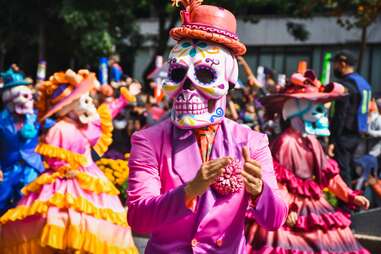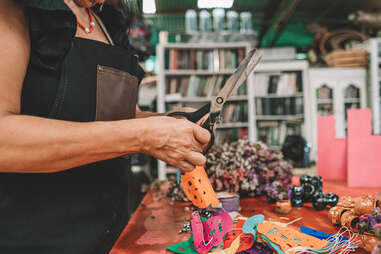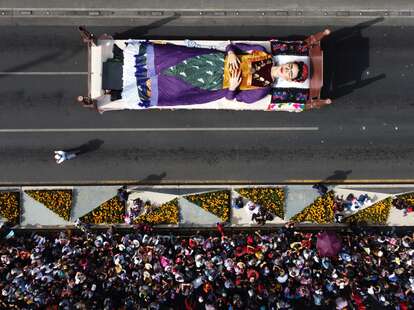Honor the Dead in Style at Mexico’s Best Día de Muertos Events
Mingle with the dead in the vibrant land of the living.
Grief-tinged gaiety, gravesite reunions, and skeletons on stilts—Día de Muertos is celebrated both publicly and privately in parks, plazas, cemeteries, and homes all around Mexico. Not to be confused with Halloween—another holiday touting parades and colorful costumes—Día de Muertos (a.k.a. Day of the Dead) is all about families gathering to honor loved ones who have passed on.
This time of year, the dead are said to temporarily travel back to the land of the living, consuming the meals, mezcal, pulque, and other offerings left for them on altars, or ofrendas, typically incorporating the four elements. Flickering candles illuminate the spirits’ annual return, while water quenches their thirst after the long journey. Food and seeds represent the earth, and brightly colored paper banners called papel picado signify the air. Ofrendas may also include sentimental gifts, photographs, sugar skulls signed with the names of the deceased, and copal incense lit to purify the environment. Mexican marigolds called cempasúchil feature prominently as well—also known as flor de muerto or flowers of the dead, these pungent, sunny petals are said to guide the souls back home.
Día de Muertos customs, levels of grandeur, and gastronomic details might vary from state to state, but all the celebrations share a deep respect for and acceptance of death. A merging of Catholic and pre-Hispanic beliefs, the festivities take place on All Saints’ Day and All Souls’ Day: November 1 focuses on departed children, while November 2 commemorates deceased adults. Preceding days also acknowledge different types of death. October 27 features a vigil for orphaned souls with no living survivors, October 28 remembers those who’ve passed away tragically or accidentally, and October 30 and 31 are dedicated to children who perished before baptism. No soul is left behind.
In 2018, Día de Muertos was added to UNESCO’s Intangible Cultural Heritage list, while recent pop culture visibility from the likes of James Bond’s 2015 hit, Spectre, and Pixar’s animated blockbuster, Coco, helped to catapult this holiday from an intimate and traditional affair to all-out spectacle and top tourist attraction. And if you’re lucky enough to head south of the border during this period, you’d be remiss not to check out the festivals outlined below. Here are 10 of the coolest, most colorful Day of the Dead celebrations in Mexico.

More like Month of the Dead. Every October through early November, Mexico City pulls out all the stops for its Día de Muertos celebrations in the historic city center and surrounding outskirts. On weekend evenings, you can catch a haunting lakeside performance about the legend of La Llorona (the Weeping Woman) and her vengeful shenanigans from the comfort of a trajinera in Xochimilco, located about 40 minutes outside the city. Highlights in the historic center include the annual parade of alebrijes (mystical creatures), UNAM’s mega ofrendas honoring national heroes, the 5K or 10K Calaveritas Run through Chapultepec Park, and the massive Procession of the Catrinas.
Without question, the most unmissable event during this month-long feast for the senses is the Grand Parade or El Gran Desfile del Día de los Muertos, a procession that winds it way through Chapultepec Park, Paseo de la Reforma, and Zócalo. A case of life imitating art, Mexico City held its first large-scale Día de Muertos procession in 2016, the year after the 007 film Spectre depicted a similar event in its opening scene. The route is a vivid mishmash of flower-bedecked floats, grandiose puppets, dancing stilted performers, and millions of jubilant onlookers—roughly 2.6 million people attended Mexico City’s Day of the Dead parade in 2019. This year, the Grand Parade falls on Saturday, November 4.
Oaxaca
Ancient traditions thrive in the Mexican state of Oaxaca, widely considered one of the best places in the world to experience the Day of the Dead. Discover the region's unique take on the celebration by visiting villages and towns like Huautla de Jiménez, where you’ll be awestruck by S’ui K’ien, the Mazatec party of the dead. During this culturally rich fiesta, you can cavort with huehentones, men and women wearing masks meant to resemble the elderly, while dancing to percussion- and violin-heavy folk music.
If you want to party until the wee hours, hit the town of San Agustin Etla, known for its boisterous comparsas, i.e. carnival-esque costumed song and dance processions. You can also pay your respects at the Panteón Viejo and Panteón Nuevo cemeteries in the village of Xoxocotlán, complete with spirited celebrations with mariachis in tow. In Oaxaca City, the mole and mezcal flow freely for days—you’ll want to snap up accommodation well in advance—and the comforting aroma of pan de muerto fills the streets. Be sure to sample this Oaxacan signature, a sweet, fluffy, “bread of the dead” painted with tiny festive faces.
Michoacán
Coco director Lee Unkrich traveled widely around Mexico when dreaming up his award-winning tearjerker, and the cities and towns of Michoacán ended up serving as significant visual references for the animated movie. The state also offers numerous Day of the Dead festivities, the most popular going down on the compact island of Janitzio in Lake Pátzcuaro.
For a thoroughly enchanting experience, take a wooden boat from Pátzcuaro (one of Mexico’s Magical Towns) to Janitzio and take in the beautiful Indigenous ritual of Purépecha (also known as Tarascans), when crowds gather to light candles on the water.
Once sufficiently charmed by the floating vigils, busy yourself with tasting the region’s culinary treasures: blackberry tamales, uchepos (tender corn tamales), and cheese-topped Tarascan bean with tomato soup. Janitzio attracts thousands of spectators, so you might want to also investigate alternative Michoacán locales like capital city Morelia.

Mazatlán, Sinaloa
Pop over to Mazatlán for Día de Muertos merrymaking with a coastal twist. This historic city sports 12 miles of Pacific shoreline, with Paseo Olas Altas’s two-day waterfront procession delighting both the living and the dead each November.
Plaza Machado, with its 19th century buildings mere minutes from the beach, is another hub of activity. Each year, the leafy town square is decorated according to a designated theme—2021 was called Metamorphosis, Myths, and Legends of Mexico, while 2022 honored La Catrina, Queen of Mexican Traditions. This year’s Art Legends from Mazatlán is a posthumous tribute to creative locals with exhibits, readings, and guided tours of the Municipal Arts Center available. Exhibit tickets are free but must be reserved in advance via the 1874-built Ángela Peralta Theater ticket office.
Altars are also sprinkled throughout the city—at the Mazatlán Film & Theater and La Casa de Caracol bookstore for instance—and the main event is the post-sunset Callejoneada parade on November 1.
Aguascalientes
Across Mexico, one of the most iconic symbols of Día de Muertos is La Calavera Catrina, or the Elegant Skull. This sophisticated yet macabre secular icon was created by political lithographer José Guadalupe Posada circa 1910 as a critique of Europe’s increasing influence on Mexican women’s fashions. Then, in the 1940s, famed artist Diego Rivera positioned her front and center in his sprawling Mexico City mural, Dream of a Sunday Afternoon in the Alameda Central, cementing her legendary status.
As the birthplace of José Guadalupe Posada, Aguascalientes rightly takes Day of the Dead celebrations to the next level with a multi-day, skull-strewn extravaganza. During the Festival de Calaveras (Festival of Skulls) from October 28 to November 5, larger-than-life skeletal sculptures parade through the streets. Fireworks, performances, costume contests, charrería matches, a symphony orchestra, and a pan de muerto pavilion are thrown in for good measure.
Though Aguascalientes is Mexico’s second smallest state, it has one of the biggest Día de Muertos soirees in the country and the holiday is never far away. You can brush up on all things Catrina year-round at the José Guadalupe Posada Museum or the Museo Nacional de la Muerte (Museum of Death).

Riviera Maya and Cancún
In the Yucatán Peninsula, Día de Muertos is known as “Hanal Pixán.” And throughout the region, events range from humble processions to commercialized mega-events featuring cameos from Latin superstars.
In Playa del Carmen, don your best Catrina costume and join fellow revelers for a free and informal gathering at Municipal Square. In Cancún, the municipality puts on an event in the Puerto Juárez area near the Isla Mujeres ferry dock that tourists are welcome to attend. You can also purchase a package (including round-trip transportation) to see Hanal Pixán in the Mayan community of Tres Reyes complete with a cenote visit.
Now in its 17th year, the Festival de Tradiciones de Vida y Muerte organized by Xcaret Ecopark is the grandest—albeit quite commercial—ticket in Riviera Maya. Running from October 30 to November 3, the culture-focused soiree promises craft workshops, interactive exhibits, low-lit cemetery tours, folkloric ballets, and Mexican pop-rock singer Natalia Lafourcade in concert.
Cuajinicuilapa, Guerrero
Guerrero’s Costa Chica area is known for its prominent population of Mexicans of African descent. In the municipality of Cuajinicuilapa, roughly four hours from Acapulco, residents preserve the memory of their ancestors with the physically intensive dance of the devils (la danza de los diablos). The performers—usually men and boys—wear masks with elongated beards and mustaches made of horse hair as they stomp to the beat of harmonicas and charrascas fashioned from the jaws of horses and donkeys.
Catch the fancy footwork in Cuajinicuilapa on November 1 and 2, and dive into the history of Afro-Mexicans and Afromestizos with a visit to Museo de las Culturas Afromestizas Vicente Guerrero Saldaña.

San Miguel de Allende, Guanajuato
San Miguel de Allende’s already high charm factor soars during Día de Muertos, when you'll find artistic and spiritual elements merging in the form of gallery tours and intimate costume contests at various venues. Those staying at stylish hotels like Rosewood San Miguel de Allende are treated to Catrina makeup sessions and exclusive gala dinners. And at Casa de Sierra Nevada, Mexican visual artist Bestabée Romero is designing personal altar kits to help guests make their own commemorative ofrendas. Life in this UNESCO-listed city is perennially filled with art.
For a more public spirit-welcoming gathering, hop on a Catrinas parade or join the San Miguelenses as they visit flower-strewn graves at Panteón de Nuestra Señora de Guadalupe.
Todos Santos, Baja California Sur
A few places in Mexico hold tapete-making competitions as part of their Día de Muertos practices, and one of the top places to see it is Baja California Sur’s Todos Santos. Tapetes are sawdust carpets that incorporate organic materials like sand, dyed sawdust, flower petals, salt, and beans into extraordinary designs. The illustrations often depict skulls and religious imagery, and can stretch on for blocks on end. During the Magical Town’s four days of Día de Muertos revelry (October 30 to November 2), skilled tapete-makers go head-to-head in a quest to be crowned champion at the Concurso de los Tapetes.
For those with a competitive streak, the fun doesn’t end there. Todos Santos hosts community-focused showdowns to determine the very best altar, top-notch Day of the Dead imagery, the best-dressed Catrinas, and even the most stylish costumed pets. Each contest takes place in the town’s central plaza where a monumental communal altar stands tall.
Pomuch, Campeche
Pomuch, a quaint town in Campeche, offers a distinctive Día de Muertos experience that’s not for the faint of heart, thanks to Choo Ba’ak, the local tradition of exhuming and hand-cleaning bones of a person buried for at least three years. The bones are then lovingly and meticulously tended to every year after that.
In this time-honored custom, families gather at the cemetery armed with brushes or pieces of cloth as their preferred instruments. Boxes holding the polished bones are left ajar to give the departed fresh air while embroidered white tablecloths bear the names of the deceased. Visitors can observe this meticulous practice at Cementerio de Pomuch during daylight hours.
